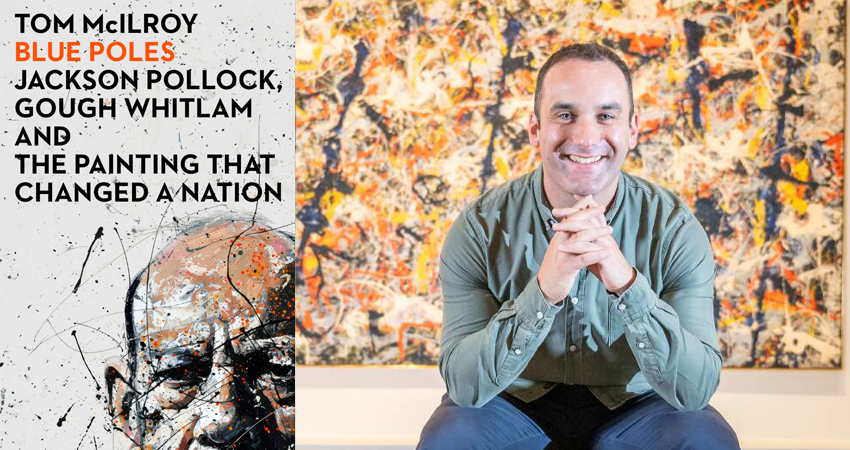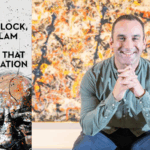Review: Blue Poles, Tom McIlroy, Hachette
In 1973 the Whitlam Government bought Jackson Pollock’s painting Blue Poles for an at-the-time whopping $2 million, destined for the as-yet-unbuilt national gallery in Canberra. (For comparison, the median house price was less than $20,000.) The purchase was a major cultural step forward for Australia, but it was controversial, caught up in the general maelstrom surrounding Gough Whitlam.
Many Australians were enraged that Whitlam, to paraphrase a famous criticism of artist James Whistler, had flung a painting of flung paint pots at their faces. Critics called it ‘incoherent’, ‘chaotic’, a ‘gimmick’ and ‘difficult’. Comedian Paul Hogan held his nose in front of the painting and uttered the unoriginal critique that his daughter could have painted it. It was a boon for cartoonists. Some art world elites thought it was just flashy and trendy, and the gallery could have bought more historic works instead.
The story of the purchase and the fallout takes up the second half of Tom McIlroy’s book. It’s fascinating, but not a long story, so McIlroy has added a brief biography of Pollock, and background to the painting and Abstract Expressionism generally, to his book, to give context about why the painting, and not just the sale, was so controversial.
Pollock was an arch-modernist who reflected the shift of the centre of the art world from Paris to New York. He was a beneficiary of President Roosevelt’s scheme for helping artists during the Great Depression, and a student of Thomas Hart Benton, who said that he taught Pollock about the rhythm and structure later built into Blue Poles.
There is some dispute over who taught Pollock his infamous drip technique – it seems many were experimenting with such things in New York at the time. But the important thing about Pollock’s work was that he went beyond the accidental and controlled the drips to create his own style, which showed an energetic ‘delicacy’, according to critic Robert Hughes.
Being classed as genius has meant a lot of mythology has stuck to Pollock’s biography, including accounts of frantic all-night sessions to meet deadlines, though his alcoholism probably could not be exaggerated much more, as destructive as it was. Like Van Gogh, and in contrast to the myth of the tortured artist, it was not Pollock’s dark times that brought out his best, but happier times, such as when he lived on Long Island with the artist Lee Krasner, whose key role in getting Pollock over the line, is now acknowledged. It was on Long Island, in a farmhouse barn, that Pollock created his so-called ‘all-over’ paintings, which included Blue Poles.
At the end of the 1940s Pollock was earning and famous, but critics were divided about where he had taken American art. One critic said, predictably, he could have painted the works himself, while another described them as a ‘snarl of tar and confetti’. It is remarkable that twenty years later Pollock’s art was still unacceptable to some. For what it’s worth, Pollock wasn’t entirely convinced by the painting. As is sometimes the case with groundbreaking works, it didn’t sell initially, and Pollock’s gallery owner stored it rolled-up in a stairwell in his apartment building. But it is now generally regarded as Pollock’s masterpiece, with one critic describing it hyperbolically as the best American painting ever.
The painting was not unrelated to Whitlam’s later dismissal. Blue Poles, for some, was indicative of Whitlam’s recklessness. And there was an element of tall poppy syndrome there too. Somewhat ironically, Whitlam was criticised as an elitist too preoccupied with the arts. But he wanted to give more art to the public instead of it being locked up in private hands. He was an advocate for the role of the arts in public life and felt, at the time, that Australia was falling behind. And so he tasked the national gallery director James Mollison with roaming the globe in search of iconic modern works and spending big.

There were supporters. The painter Russell Drysdale thought it was a good painting and said the public had to be realistic about art prices. At least where Blue Poles is concerned, history is on Whitlam’s side. The painting, in hindsight, was a very good investment. Whitlam later said that if he had made a mistake in buying the painting, the Fraser Government could have sold the painting for a tidy profit – which they didn’t, and that they didn’t was his vindication.
Nick Mattiske blogs on books at coburgreviewofbooks.wordpress.com and is the illustrator of Thoughts That Feel So Big.












